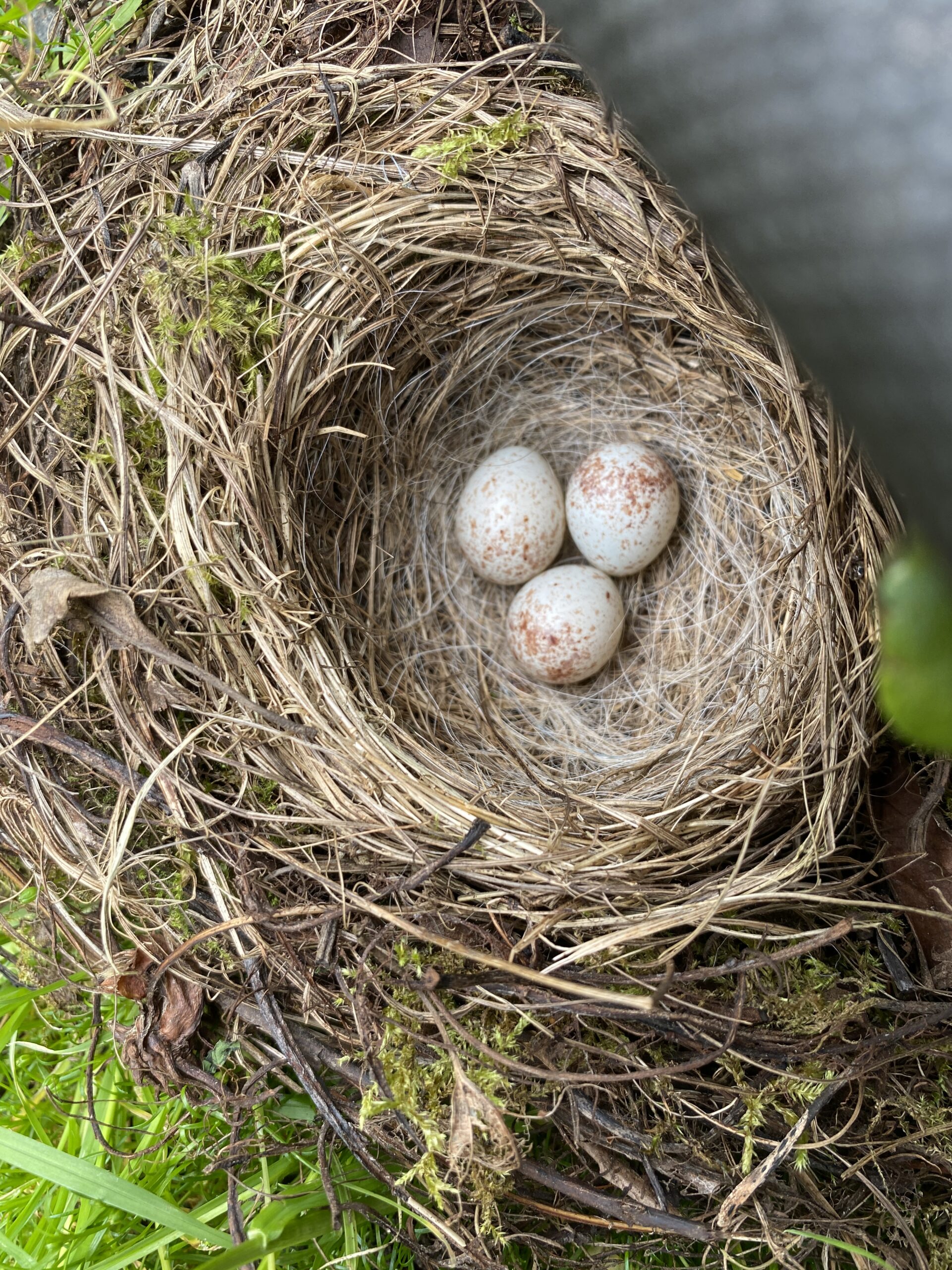
From intrepid gardener / commentor OpieJeanne:
We replaced a wooden raised bed that was too low with two metal watering troughs. I never got around to trimming the excess weed cloth. On June 7th I was hunting slugs in the garden (I imagine them squealing as they see the trowel descending to scoop them up), and discovered that they really like to hide under the edges of that weed cloth because it was cool and damp.
I worked my way around, and when I raised the weed cloth I found a nest on the ground with one egg. My niece figured out that it belonged to a dark-eyed junco. The next day there was another egg, and the next there was a third. I stopped looking under the weed cloth after that because I disturbed the mother sitting on the nest and realized she was finished laying eggs.
It was a little awkward working in the garden around that nest and not frightening the mom. If we got too close she’d emerge from under the weed cloth and run slowly away from us in the classic “chase me instead of messing with my babies”.
Dark-eyed junco eggs take about 12 days to hatch once incubation starts, and on June 19th we realized that there was a lot of activity at the nest by two juncos, that the babies were hatching and were being fed.
Juncos are primarily seed-eaters, but their nestlings need protein, so mom and dad diligently foraged for little green worms and other insect pests from the garden above the nest. Our peas, cabbages, and bok choi have very little damage from things that chew on the leaves.
Juncos make a ticking sound when they’re alarmed, and we got ticked at a lot. We sat in the shade of a cherry tree at what we thought was a suitable distance, to watch them ferrying little green worms to the nest, and they’d perch right above us, clicking their tongues in disgust until they got bored or decided we weren’t a threat.
There was one day when four crows were exploring the tomato bed right next to the nest, a definite threat to the newly hatched chicks, but we sat in the garden until the crows got bored and left. Mama bird sat over us, ticking very quietly because she didn’t want to take on four huge crows. That took about an hour, and when the last crow left the perimeter of the property, she swooped back to her nest but she wasn’t going to do that while there was a crow perched in any of the trees around the yard.
As the babies got closer to fledging (11-12 days after hatching), the junco parents expanded their turf until it took up the whole garden.
On June 28th they were out of the nest but not yet ready to fly. We checked on them during the day and they had gradually moved away from the nest until on the 30th they were in some tall buttercups, about a yard from the nest. I don’t know how they got there, and we only realized where they were when we saw the parents flying into that clump of weeds and knew they were still feeding the babies.
In another day or two they will be able to fly as well as their parents, 25 days from egg to fully fledged and flying. We thought we’d see them perched on the edges of the raised beds, squawking to be fed but maybe not.
What’s really amazing to me is that they produced three eggs, hatched all three, and managed to keep them alive.
Addendum — July 4th:
***********
What’s going on in your garden(s), this week?

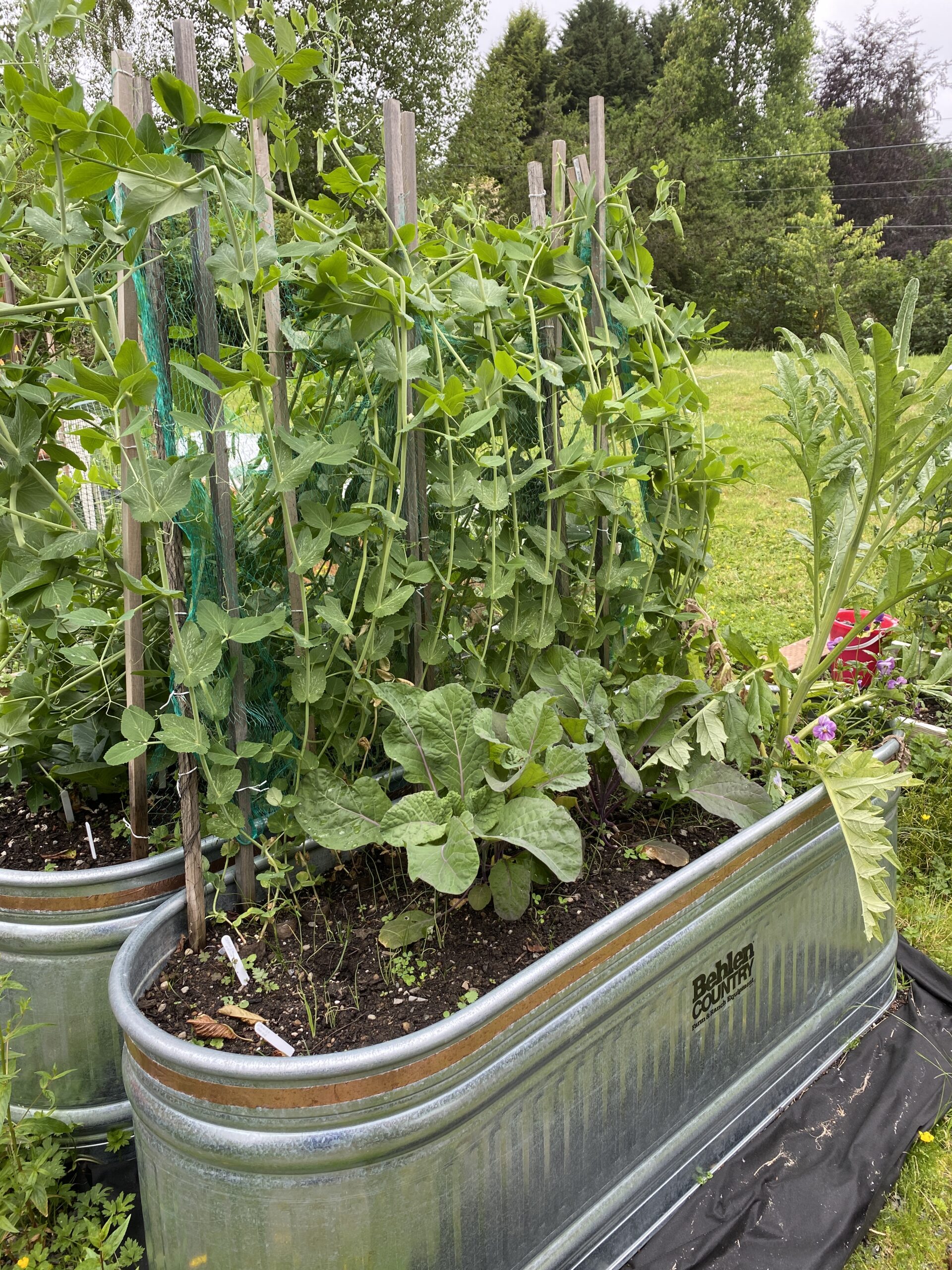
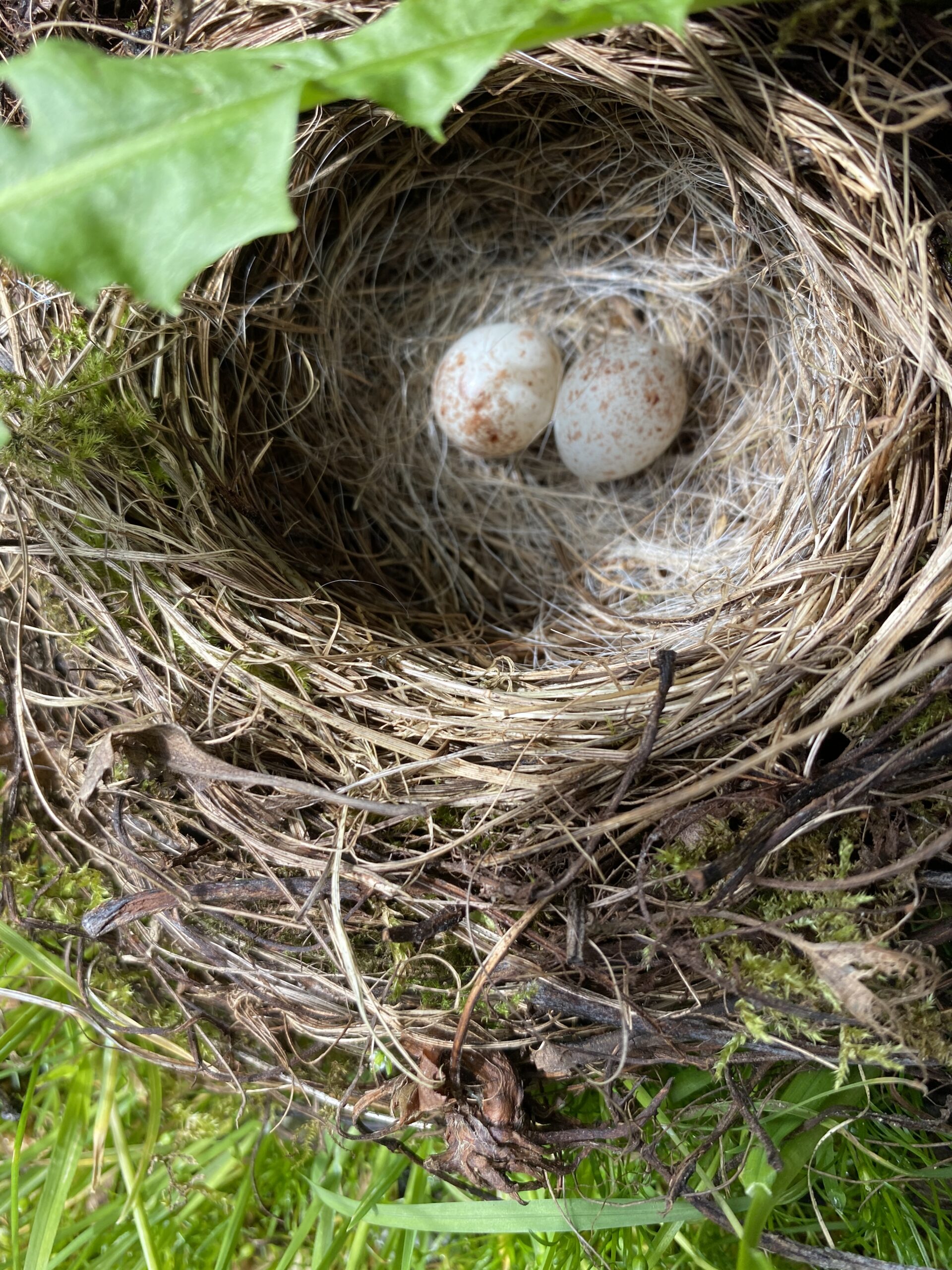
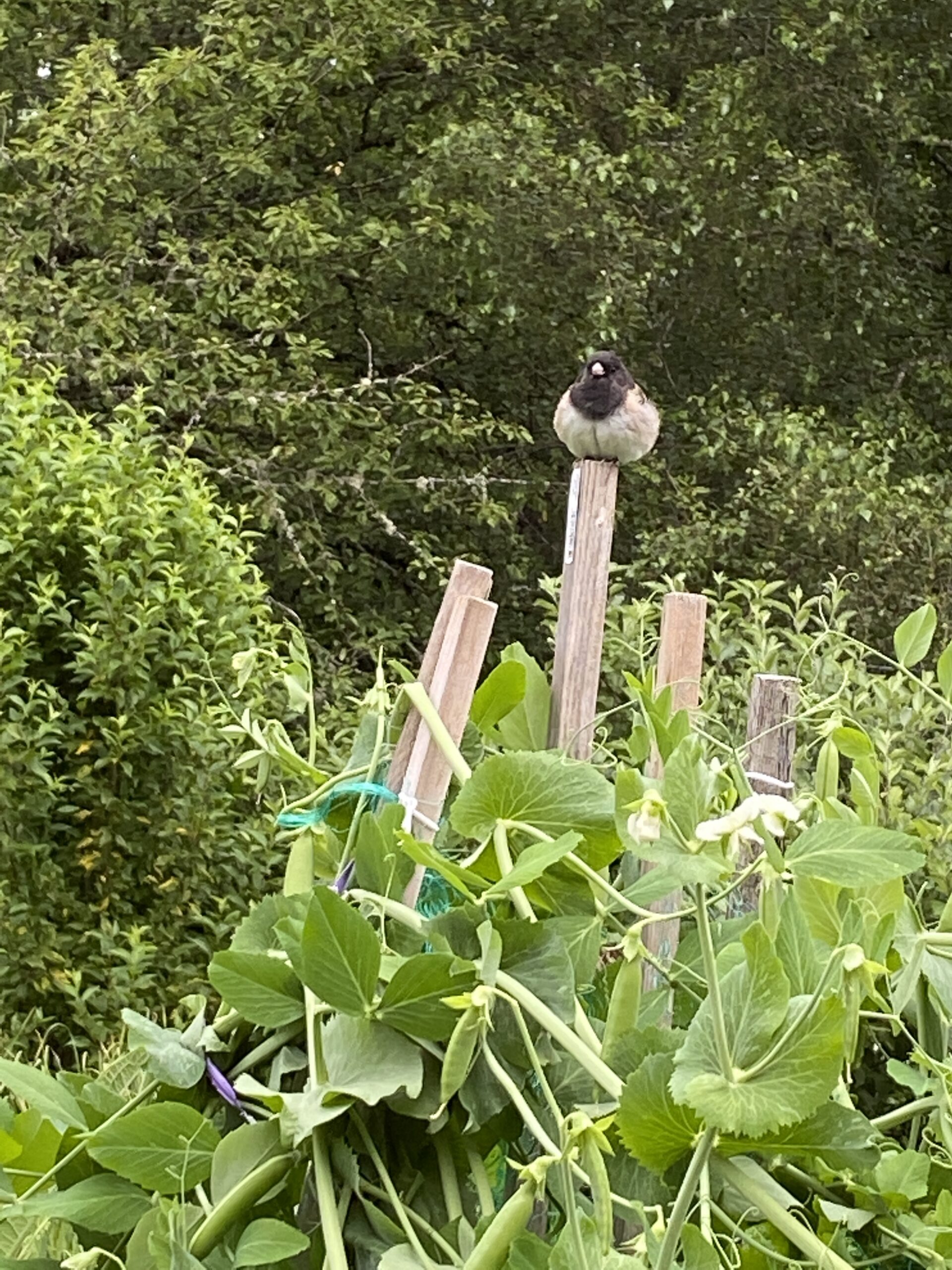
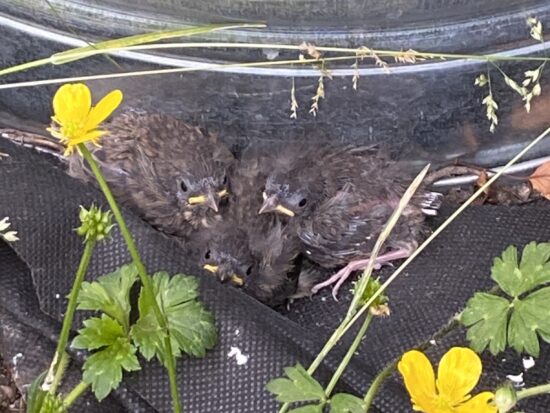
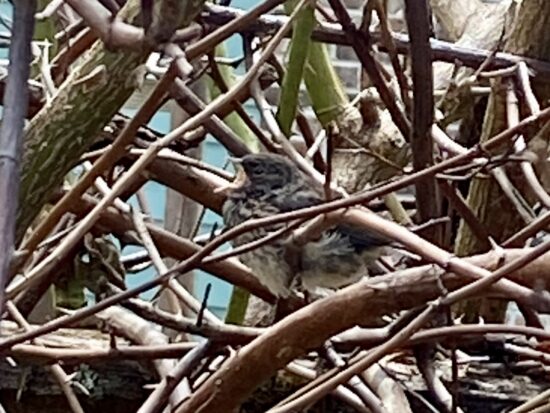
Lapassionara
What a lovely story. We had a robin nest on top of our mail box one year. Watching the baby birds grow was a thrill. Once they were out of the nest, we could see them trying short flights to low lying branches. We lost track of them after that, and I always worried that they got eaten by a hawk or owl. We haven’t seen another nest in several years.
thanks, Opiejean.
Betty Cracker
Good job, Junco parents!
Betsy
This is the best.
raven
Cool!
Spanky
Love this story!
OzarkHillbilly
Albatrossity on Sunday! What? Opiejeanne?
Huh, could’a fooled me. Thanx Opiejeanne.
We have Eastern flycatchers nesting in our carport every spring. They fledge out 2 broods a year. If the black snakes don’t get them. We also get a nest of Carolina Wrens in the wood shed, and summer tanagers out in the woods somewhere. And others, but those are the ones I look for every year.
Jeffery
A robin decided to build a nest in the apple tree over the bird bath this spring. They were not happy about me changing the bird bath daily.
Have picked Kirbys and summer yellow squash. The first tomato is turning red ever so slowly. I found this tomato growing in a space between the bricks in the street walk last year. Pulled it out and planted it in the garden. It is a designer tomato. Perfect shape. Perfect red color. Hard as a rock even when fully red. Has to sit for a week or so before eating. It has to have some give when squeezed before it is ready. Actually tastes very good if allowed to fully ripen. Saved seeds from last year and grew it again. Not sure if it will breed true. We’ll see.
Betsy
@OzarkHillbilly: Do you maybe mean Eastern kingbirds? or Great Crested Flycatchers? Or some other flycatcher – a flycatcher that nests in a structure is weird and exciting! and I don’t find a bird with that name. ETA: Maybe Eastern Phoebe?
OzarkHillbilly
@Betsy: Eastern Phoebe, yes. We call them flycatchers here.
Albatrossity
Very cool! Yes, the fact that they raised all three eggs to full junco-ness is really wonderful!
satby
What a great picture story opiejeanne! Thanks for that. Your garden is looking good too
MomSense
I love this story. It gave me all the feels especially as I’m counting down to my third leaving the nest.
CarolPW
I always imagine that the juncos are saying tsk tsk at us for annoying them.
Betsy
@OzarkHillbilly: got it! Being a bit of a picky lister type, I go by the one official name to avoid confusion, but I also like regional names for things, like my grandmother called the Pied-Billed Grebes “die-dappers.”
J.
I love this post! ❤️
Wapiti
Nice story of the juncos. We have juncos and I knew they were ground nesters, but I’ve never seen a nest here.
Immanentize
Thanks Opiejean. First time I remember a garden chat including a harvest of tweeties.
Immanentize
@OzarkHillbilly: Did you get a heat break?
oldgold
Before the drought, West of Eden had a lot of bird nests. Then, it got so damn dry the birds started laying powdered eggs. With that, the nests bit the dust. This post made me nestalgic for wetter times.
How dry is it in the Twilight Hardy Zone, well, the local Fish Wrapper, now locally called the Suckulent, is reporting the two political parties have stopped throwing mud at one another. Even more shocking, it is reporting that the local NRA chapter has agreed to the regulation of waster pistols. More incredible, in the church news section, there are reports the Catholics are praying for Jesus to turn wine back into water and the Baptists are issuing rain checks for baptisms.
Kristine
I love the juncos. They signal the arrival of winter here in far NE Illinois.
So far I’m batting 0 for 2 in the nature babies department. House finches built a nest in the space between a garage light and the garage, but crows raided the nest after Mom laid their eggs and so much for that.
Then *5* monarch eggs hatched on my two common milkweed, but the caterpillar numbers dwindled over the last few days and now I think they’re all gone. I know their survival rates are low in the wild–2-10%–but I was hoping at least one would make it.
Garden-wise, bee balm are blooming, as are day lilies. Parts of a hydrangea I’d given up on and dug up a few years ago revived and grew into a small shrub that actually flowered! However, it grew in a tangle of hosta and bee balm so I need to perform some careful plant surgery when fall arrives. Early summer heat blasted some of my astilbes–I need to move all the ones that get afternoon sun because the poor things look like they’ve been torched. The hosta in the shade garden are in various stages of bloom. I know some folks sniff at them because they’re freaking ubiquitous, but their flowers are gorgeous. Underrated plants imo.
opiejeanne
@Jeffery: What are kirbys?
We’ve eaten all of our first crop of radishes and bok choi, still have lots of sugar snap peas, spinach, mizuna, and Swiss chard. The leaf lettuce was tricky to get started this year, black seeded Simpson, but the strawberries have been really good, if small. I made strawberry ice cream last week and we’ve had strawberry shortcake several times.
The metal bed next to the nest has the cleanest cabbages I’ve ever grown, not a single bite out of the heirlooms or the miniature cabbages, and I thank the junco parents for that.
StringOnAStick
I didn’t put in any veggies last year because I was in the process of a total redesign of the backyard of our new home. I delayed doing it this year because I was waiting for an irrigation contractor who I’ve officially given up on, and just finished putting together a watering system using drip pipe and shrubblers that I can screw the hose into, turn on and watch my timer. It would have been a great year for peas since the first real heat starts tomorrow; oh well, next year.
The pie cherries are just starting to ripen, about 1-2 weeks later than last year because of the long cool spring. Last year we were baking starting in June, and this cool weather means all the hard labor I did last summer to get the backyard ready to plant perennials and shrubs earlier this year has paid off handsomely. I have put together my lifetime landscape masterpiece, and I’m feeling satisfied that all my years of gardening, observing and learning has helped out together something special that we’ll enjoy for the rest of our lives.
Kristine
@StringOnAStick: Looking forward to photos if possible.
J R in WV
We have a ton of birbs here, of all sorts from hawks and owls to flycatchers and towees, the occasional /great Blue Herons, piliated woodpeckers are the flashiest woodpecker. I have a photo of a Barred Owl sitting in a tree looking at Wife, who si not in the photo. It’s a little weird looking because I shot the pic through a thick double pane of glass, but pretty clear. I haven’t done any editing, may make it more normal in that process, we’ll see.
I also have some photos of my ramp patches in bloom. The ramp foliage dies back in early spring, after sprouting in late winter, the first green thing to sprout. Then several weeks after they disappear, tiny spears sprout, with little red spearpoints, which after a week or so explode into round spheres of white blossom.
Now as we pass into hot summer days, many of the little white blooms are turning into green seed pods. The actual ramp roots spread by sending underground runners all around the edges of each set fo ramp roots, while seeds can spread much further.
Anyways, will be some photo sets from WV’s wooded hillsides sometime soon!
Thanks to all who have gardens and share photos. I’m so impressed by all the hard work people are putting in to their gardening. All our gardening involves shade tolerant perennials.
trollhattan
Birbies! Love the story and outcome and pics, etc.
jnfr
It is too hot to garden, but I am mostly managing to keep things watered. That’s about all I can do this time of year.
CaseyL
Dark-eyed juncos! Those are the same birds that were clicking away at me a few weeks ago when my cat was scaring them (I dragged him back inside).
I always see them here in our townhouse complex, and have wondered what they are.
Thank you for identifying them! – and thank you for not disturbing them.
PBK
@oldgold: nice!
schrodingers_cat
Gardeners I have two questions
Thanks.
The Lodger
Kirbys are pickling cucumbers. They also share a name with our late lamented opinionated white cat, which was always a source of amusement for the family.
opiejeanne
@The Lodger: thanks.
mvr
@Betsy: Cordilleran Flycatchers regularly nest on the flat parts of our cabin beams in the Sierra Madre Mountains of Wyoming. And that is a definite id both by sight and by sound. FWIW.
mvr
Juncos are some of my favorites and I don’t know why. We get them here in Lincoln NE in the Spring (and I think Fall too) but not over the summer. And we get them in the mountains of Wyoming over the summer. There are different sub-species with different coloration. I’ve now learned to recognize the flash of white in the tails of the ones we see in the mountains even when they otherwise are moving too fast to id. And I recognize the tics of which you speak.
Thanks!